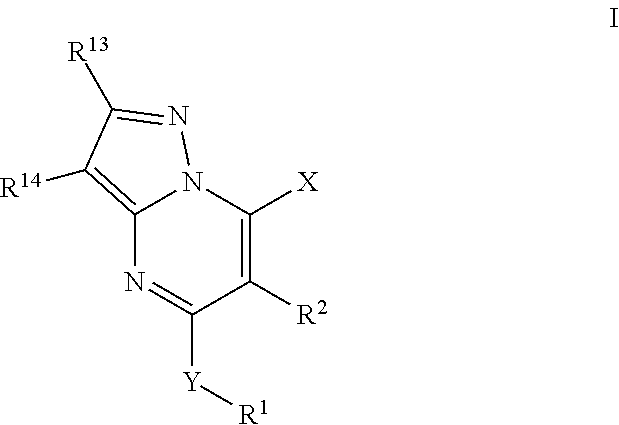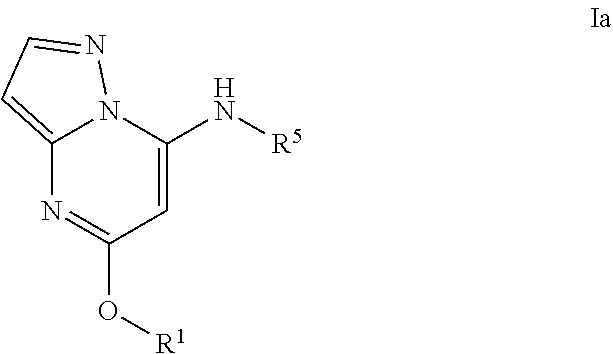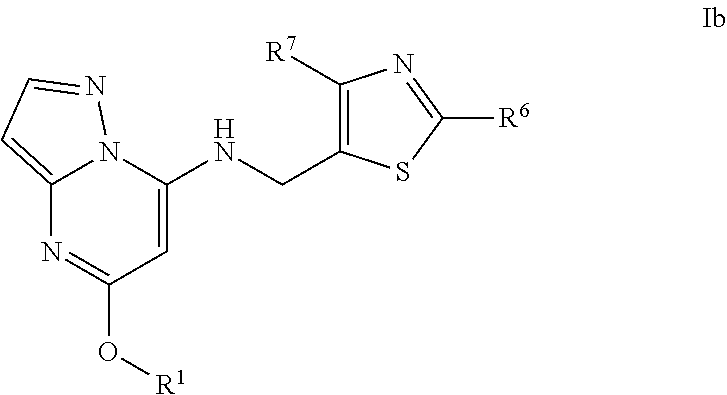Pyrazolopyrimidine PDE 10 inhibitors
a technology of pyrazolopyrimidine and inhibitors, which is applied in the field of compounds, can solve the problems of high non-compliance or discontinuation rate of medications, lack of efficacy, and dissatisfaction with therapy
- Summary
- Abstract
- Description
- Claims
- Application Information
AI Technical Summary
Benefits of technology
Problems solved by technology
Method used
Image
Examples
example 1
[0129]
(S,S)-Ethyl 2-(pyridin-2-yl)cyclopropanecarboxylate((S,S)-F1-trans)
[0130]A solution of 2-vinylpyridine (2 g, 19.02 mmol) in toluene (40 mL) was treated with ethyl diazoacetate (1.973 ml, 19.02 mmol) and stirred at reflux overnight. The mixture was concentrated in vacuo and the residue was purified by gradient elution on silica gel (0 to 50% EtOAc in hexanes) to elute peak 1; the solvent gradient was then ramped to 100% EtOAc to elute peak 2. This yielded the title compound (1.6 g, 44%) as the first eluting diastereomer, and the corresponding cis diastereomer (914 mg, 25%) as the second eluting diastereomer, both as yellow oils. Data for F1-trans: 1H NMR S (500 MHz, CDCl3): 8.44 (m, 1H), 7.56 (td, J=7.6, 1.7 Hz, 1H), 7.22 (dd, J=7.8, 1.0 Hz, 1H), 7.08 (ddd, J=7.6, 4.9, 1.2 Hz, 1H), 4.17 (q, J=7.3 Hz, 2H), 2.58 (ddd, J=10.0, 6.1, 3.9 Hz, 1H), 2.25 (ddd, J=9.5, 5.6, 3.9 Hz, 1H), 1.61, (m, 2H), 1.28 (t, J=7.1 Hz, 3H). LRMS (ES) calculated M+H for C11H13NO2S: 192.2. Found: 192.1. E...
example 2
[0132]
2-Vinylquinoline (G1)
[0133]A solution of 2-chloroquinoline (1 g, 6.11 mmol) and vinyl tributyl tin (2.69 mL, 9.17 mmol) in toluene (30 mL) was treated with Pd(PPh3)4 (0.706 g, 0.611 mmol) and heated to reflux for 1.5 h. The reaction mixture was concentrated and the resulting material was purified directly by gradient elution on silica gel (0 to 25% EtOAc in hexanes) to afford the title compound as a colorless oil (941 mg, 99%). All spectral data matched literature values. Fakhfakh, M. A.; Franck, X.; Fournet, A.; Hocquemiller, R.; Figadère, B. Tetrahedron Lett. 2001, 42, 3847. LRMS m / z (M+H) 156.1 found, 156.2 required.
Ethyl 2-(quinolin-2-yl)cyclopropanecarboxylate (G2-trans)
[0134]A solution of G1 (941 mg, 6.06 mmol) in toluene (20 ml) was treated with ethyl diazoacetate (0.629 mL, 6.06 mmol) and stirred at reflux overnight. The mixture was concentrated and the residue was purified directly by gradient elution on silica gel (0 to 30% EtOAc in hexanes) to elute peak 1 (trans di...
example 3
[0136]
Ethyl 3-(1,5-naphthyridin-2-yl)prop-2-enoate (H1)
[0137]2-chloro-1,5-naphthyridine (101 mg, 0.614 mmol), boronate ester B1 (195 mg, 0.920 mmol), S-Phos (25.2 mg, 0.061 mmol), K3PO4 (391 mg, 1.841 mmol) and PdOAc2 (6.89 mg, 0.031 mmol) were combined in a 5-mL microwave vial in THF (2.5 mL) and water (500 μl). The reaction mixture was heated at 100° C. for 15 min. The reaction mixture was diluted with EtOAc (20 mL), washed with sat. aq. NaHCO3 (25 mL) and brine (25 mL), dried over MgSO4, filtered, and concentrated in vacuo. The resulting residue was purified by gradient elution on silica gel (10 to 100% EtOAc in hexanes) to afford the title compound as a pale orange solid (118 mg, 90%). 1H NMR (500 MHz, DMSO): δ 9.02 (dd, J=4.1, 1.6 Hz, 1H), 8.48 (d, J=8.8 Hz, 1H), 8.48-8.42 (m, 1H), 8.25 (d, J=8.7 Hz, 1H), 7.84-7.79 (m, 2H), 7.13 (d, J=16.0 Hz, 1H), 4.25 (q, J=7.1 Hz, 2H), 1.30 (t, J=7.1 Hz, 3H) ppm; LRMS m / z (M+H) 229.2 found, 229.1 required.
Ethyl 2-(1,5-naphthyridin-2-yl)cyclo...
PUM
| Property | Measurement | Unit |
|---|---|---|
| PKA | aaaaa | aaaaa |
| temperature | aaaaa | aaaaa |
| temperature | aaaaa | aaaaa |
Abstract
Description
Claims
Application Information
 Login to View More
Login to View More - R&D
- Intellectual Property
- Life Sciences
- Materials
- Tech Scout
- Unparalleled Data Quality
- Higher Quality Content
- 60% Fewer Hallucinations
Browse by: Latest US Patents, China's latest patents, Technical Efficacy Thesaurus, Application Domain, Technology Topic, Popular Technical Reports.
© 2025 PatSnap. All rights reserved.Legal|Privacy policy|Modern Slavery Act Transparency Statement|Sitemap|About US| Contact US: help@patsnap.com



